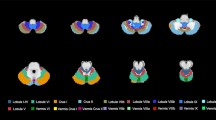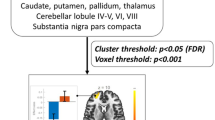Abstract
Despite previous functional MRI studies on alterations within the cerebello-thalamo-cortical circuit in patients with essential tremor (ET), the specific role of disconnection of the dentate nucleus (DN), the main output cerebellar pathway, still needs clarification. In this study, we evaluated DN functional connectivity (FC) changes and their relationship with motor and non-motor symptoms in ET. We studied 25 ET patients and 26 healthy controls. Tremor severity was assessed using the Fahn–Tolosa–Marin tremor rating scale (FTM-TRS) and tremor amplitude and frequency were evaluated using kinematic techniques. Cognitive profile was assessed by montreal cognitive assessment (MoCA) and frontal assessment battery (FAB). All participants underwent a 3 T MRI protocol including resting-state blood oxygenation level dependent and diffusion tensor sequences. We used a seed-based approach to investigate DN FC and to explore the diffusion properties of cerebellar peduncles. There was significantly decreased DN FC with cortical, subcortical, and cerebellar areas in ET patients compared with healthy controls. Correlation analysis showed that: (1) the DN FC with the supplementary motor area, pre and postcentral gyri, and prefrontal cortex negatively correlated with FTM-TRS score and disease duration; (2) DN FC changes in the thalamus and caudate negatively correlated with peak tremor frequency, changes in the cerebellum positively correlated with tremor amplitude, and changes in the bilateral thalamus negatively correlated with tremor amplitude, and (3) DN FC with the associative prefrontal and parietal cortices, basal ganglia, and thalamus positively correlated with the MoCA score. Diffusion abnormalities were found in the three cerebellar peduncles, which did not correlate with clinical scores.



Similar content being viewed by others
References
Deuschl G, Petersen I, Lorenz D, Christensen K (2015) Tremor in the elderly: essential and aging-related tremor. Mov Disord 30:1327–1334. https://doi.org/10.1002/mds.26265
Espay AJ, Lang AE, Erro R et al (2017) Essential pitfalls in “essential” tremor. Mov Disord 32:325–331. https://doi.org/10.1002/mds.26919
Bhatia KP, Bain P, Bajaj N et al (2018) Consensus statement on the classification of tremors. from the task force on tremor of the International Parkinson and Movement Disorder Society. Mov Disord 33:75–87. https://doi.org/10.1002/mds.27121
Louis ED (2005) Behavioral symptoms associated with essential tremor. Adv Neurol 96:284–290
Bermejo-Pareja F, Puertas-Martín V (2012) Cognitive features of essential tremor: a review of the clinical aspects and possible mechanistic underpinnings. Tremor Other Hyperkinet Mov. https://doi.org/10.7916/D89W0D7W
Fabbrini G, Berardelli I, Falla M et al (2012) Psychiatric disorders in patients with essential tremor. Parkinsonism Relat Disord 18:971–973. https://doi.org/10.1016/j.parkreldis.2012.05.005
Puertas-Martín V, Villarejo-Galende A, Fernández-Guinea S et al (2016) A comparison study of cognitive and neuropsychiatric features of essential tremor and Parkinson’s disease. Tremor Other Hyperkinet Mov 6:431. https://doi.org/10.7916/D86H4HRN
Hallett M (2014) Tremor: pathophysiology. Parkinsonism Relat Disord 20(1):S118–S122. https://doi.org/10.1016/S1353-8020(13)70029-4
Lin C-Y, Louis ED, Faust PL et al (2014) Abnormal climbing fibre-Purkinje cell synaptic connections in the essential tremor cerebellum. Brain 137:3149–3159. https://doi.org/10.1093/brain/awu281
Louis ED, Faust PL, Vonsattel J-PG (2011) Purkinje cell loss is a characteristic of essential tremor. Parkinsonism Relat Disord 17:406–409. https://doi.org/10.1016/j.parkreldis.2011.05.004
Buijink AWG, van der Stouwe AMM, Broersma M et al (2015) Motor network disruption in essential tremor: a functional and effective connectivity study. Brain 138:2934–2947. https://doi.org/10.1093/brain/awv225
Neely KA, Kurani AS, Shukla P et al (2015) Functional Brain activity relates to 0–3 and 3–8 Hz force oscillations in essential tremor. Cereb Cortex 25:4191–4202. https://doi.org/10.1093/cercor/bhu142
Nicoletti V, Cecchi P, Frosini D et al (2015) Morphometric and functional MRI changes in essential tremor with and without resting tremor. J Neurol 262:719–728. https://doi.org/10.1007/s00415-014-7626-y
Benito-León J, Louis ED, Bermejo-Pareja F, Neurological Disorders in Central Spain Study Group (2009) Risk of incident Parkinson’s disease and parkinsonism in essential tremor: a population based study. J Neurol Neurosurg Psychiatr 80:423–425. https://doi.org/10.1136/jnnp.2008.147223
Buijink AWG, Broersma M, van der Stouwe AMM et al (2015) Rhythmic finger tapping reveals cerebellar dysfunction in essential tremor. Parkinsonism Relat Disord 21:383–388. https://doi.org/10.1016/j.parkreldis.2015.02.003
Fang W, Lv F, Luo T et al (2013) Abnormal regional homogeneity in patients with essential tremor revealed by resting-state functional MRI. PLoS ONE 8:e69199. https://doi.org/10.1371/journal.pone.0069199
Fang W, Chen H, Wang H et al (2015) Multiple resting-state networks are associated with tremors and cognitive features in essential tremor. Mov Disord 30:1926–1936. https://doi.org/10.1002/mds.26375
Fang W, Chen H, Wang H et al (2016) Essential tremor is associated with disruption of functional connectivity in the ventral intermediate Nucleus-Motor Cortex–Cerebellum circuit. Hum Brain Mapp 37:165–178. https://doi.org/10.1002/hbm.23024
Gallea C, Popa T, García-Lorenzo D et al (2015) Intrinsic signature of essential tremor in the cerebello-frontal network. Brain 138:2920–2933. https://doi.org/10.1093/brain/awv171
Mueller K, Jech R, Hoskovcová M et al (2017) General and selective brain connectivity alterations in essential tremor: a resting state fMRI study. Neuroimage Clin 16:468–476. https://doi.org/10.1016/j.nicl.2017.06.004
Passamonti L, Novellino F, Cerasa A et al (2011) Altered cortical-cerebellar circuits during verbal working memory in essential tremor. Brain 134:2274–2286. https://doi.org/10.1093/brain/awr164
Louis ED, Joyce JL, Cosentino S (2019) Mind the gaps: What we don’t know about cognitive impairment in essential tremor. Parkinsonism Relat Disord 63:10–19. https://doi.org/10.1016/j.parkreldis.2019.02.038
Paris-Robidas S, Brochu E, Sintes M et al (2012) Defective dentate nucleus GABA receptors in essential tremor. Brain 135:105–116. https://doi.org/10.1093/brain/awr301
Louis ED, Kerridge CA, Chatterjee D et al (2019) Contextualizing the pathology in the essential tremor cerebellar cortex: a patholog-omics approach. Acta Neuropathol 138:859–876. https://doi.org/10.1007/s00401-019-02043-7
Bostan AC, Dum RP, Strick PL (2013) Cerebellar networks with the cerebral cortex and basal ganglia. Trends Cogn Sci (Regul Ed) 17:241–254. https://doi.org/10.1016/j.tics.2013.03.003
Buckner RL (2013) The cerebellum and cognitive function: 25 years of insight from anatomy and neuroimaging. Neuron 80:807–815. https://doi.org/10.1016/j.neuron.2013.10.044
Bernard JA, Peltier SJ, Benson BL et al (2014) Dissociable functional networks of the human dentate nucleus. Cereb Cortex 24:2151–2159. https://doi.org/10.1093/cercor/bht065
Wolters A, Walter U, Wittstock M, Benecke R (2014) Asymmetric postural tremor preceding DOPA-responsive Parkinsonism—the transition disease. J Parkinsons Dis 4:45–55. https://doi.org/10.3233/JPD-130287
Manto M, Perrotta G (2018) Toxic-induced cerebellar syndrome: from the fetal period to the elderly. Handb Clin Neurol 155:333–352. https://doi.org/10.1016/B978-0-444-64189-2.00022-6
Fahn S, Tolosa E, Marin C (1988) Clinical rating scale for tremor. In: Jankovic J, Tolosa E, (eds.) Parkinson’s disease and movement disorders, Urban & Schwarzenberg, Munich 1988:225–234.
Nasreddine ZS, Phillips NA, Bédirian V et al (2005) The montreal cognitive assessment, MoCA: a brief screening tool for mild cognitive impairment. J Am Geriatr Soc 53:695–699. https://doi.org/10.1111/j.1532-5415.2005.53221.x
Dubois B, Slachevsky A, Litvan I, Pillon B (2000) The FAB: a frontal assessment battery at bedside. Neurology 55:1621–1626
Jenkinson M, Bannister P, Brady M, Smith S (2002) Improved optimization for the robust and accurate linear registration and motion correction of brain images. Neuroimage 17:825–841
Smith SM (2002) Fast robust automated brain extraction. Hum Brain Mapp 17:143–155. https://doi.org/10.1002/hbm.10062
Pruim RHR, Mennes M, van Rooij D et al (2015) ICA-AROMA: a robust ICA-based strategy for removing motion artifacts from fMRI data. Neuroimage 112:267–277. https://doi.org/10.1016/j.neuroimage.2015.02.064
Diedrichsen J, Maderwald S, Küper M et al (2011) Imaging the deep cerebellar nuclei: a probabilistic atlas and normalization procedure. Neuroimage 54:1786–1794. https://doi.org/10.1016/j.neuroimage.2010.10.035
Sbardella E, Upadhyay N, Tona F et al (2017) Dentate nucleus connectivity in adult patients with multiple sclerosis: functional changes at rest and correlation with clinical features. Multiple Sclerosis. https://doi.org/10.1177/1352458516657438
Tona F, De Giglio L, Petsas N et al (2017) Role of cerebellar dentate functional connectivity in balance deficits in patients with multiple sclerosis. Radiology 287:267–275. https://doi.org/10.1148/radiol.2017170311
Upadhyay N, Suppa A, Piattella MC et al (2017) Functional disconnection of thalamic and cerebellar dentate nucleus networks in progressive supranuclear palsy and corticobasal syndrome. Parkinsonism Relat Disord 39:52–57. https://doi.org/10.1016/j.parkreldis.2017.03.008
Smith SM, Jenkinson M, Johansen-Berg H et al (2006) Tract-based spatial statistics: voxelwise analysis of multi-subject diffusion data. Neuroimage 31:1487–1505. https://doi.org/10.1016/j.neuroimage.2006.02.024
Hua K, Zhang J, Wakana S et al (2008) Tract probability maps in stereotaxic spaces: analyses of white matter anatomy and tract-specific quantification. Neuroimage 39:336–347. https://doi.org/10.1016/j.neuroimage.2007.07.053
Nicoletti G, Manners D, Novellino F et al (2010) Diffusion tensor MRI changes in cerebellar structures of patients with familial essential tremor. Neurology 74:988–994. https://doi.org/10.1212/WNL.0b013e3181d5a460
Haines DE, Dietrichs E (2012) Chapter 1—The cerebellum—structure and connections. In: Subramony SH, Dürr A (eds) Handbook of Clinical Neurology. Elsevier, pp 3–36
Manto M (2008) Tremorgenesis: a new conceptual scheme using reciprocally innervated circuit of neurons. J Transl Med 6:71. https://doi.org/10.1186/1479-5876-6-71
Cury RG, Fraix V, Castrioto A et al (2017) Thalamic deep brain stimulation for tremor in Parkinson disease, essential tremor, and dystonia. Neurology 89:1416–1423. https://doi.org/10.1212/WNL.0000000000004295
Barbe MT, Reker P, Hamacher S et al (2018) DBS of the PSA and the VIM in essential tremor: a randomized, double-blind, crossover trial. Neurology 91:e543–e550. https://doi.org/10.1212/WNL.0000000000005956
Matano S (2001) Brief communication: proportions of the ventral half of the cerebellar dentate nucleus in humans and great apes. Am J Phys Anthropol 114:163–165. https://doi.org/10.1002/1096-8644(200102)114:2%3c163:AID-AJPA1016%3e3.0.CO;2-F
Hua SE, Lenz FA, Zirh TA et al (1998) Thalamic neuronal activity correlated with essential tremor. J Neurol Neurosurg Psychiatry 64:273–276. https://doi.org/10.1136/jnnp.64.2.273
Kim J-S, Song I-U, Shim Y-S et al (2009) Cognitive impairment in essential tremor without dementia. J Clin Neurol 5:81–84. https://doi.org/10.3988/jcn.2009.5.2.81
Author information
Authors and Affiliations
Corresponding author
Ethics declarations
Conflicts of interest
The authors declare that they have no conflict of interest.
Ethical standard statement
The study was approved by the institutional review board and was carried out in accordance with the Declaration of Helsinki. All subjects provided written informed consent to the use of their data for research purposes.
Electronic supplementary material
Below is the link to the electronic supplementary material.
Rights and permissions
About this article
Cite this article
Tikoo, S., Pietracupa, S., Tommasin, S. et al. Functional disconnection of the dentate nucleus in essential tremor. J Neurol 267, 1358–1367 (2020). https://doi.org/10.1007/s00415-020-09711-9
Received:
Revised:
Accepted:
Published:
Issue Date:
DOI: https://doi.org/10.1007/s00415-020-09711-9




